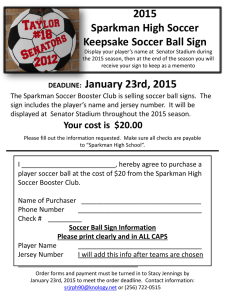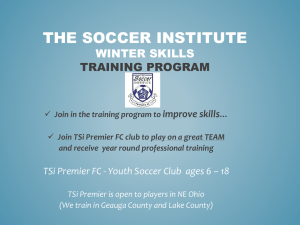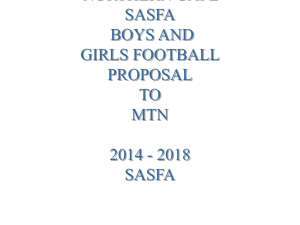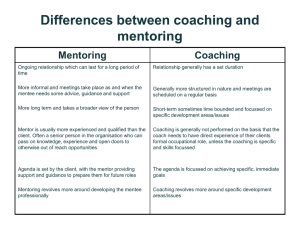Small Sided Games Presentation
advertisement
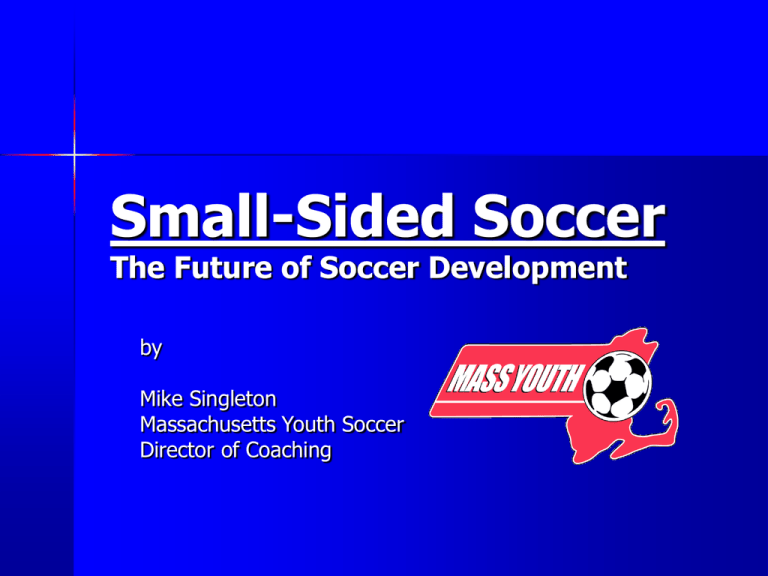
Small-Sided Soccer The Future of Soccer Development by Mike Singleton Massachusetts Youth Soccer Director of Coaching REASONS FOR SMALL-SIDED The fewer players on the field, the more players will get to touch the ball The more players touch the ball, the more skillful they will become As skills grow, enjoyment increases Mike Singleton---Director of Coaching Massachusetts Youth Soccer Why is it more fun? Children enjoy participation more than observation 1 ball: per 6 players in 3 vs. 3 per 22 players in 11 vs. 11 Mike Singleton---Director of Coaching Massachusetts Youth Soccer Why is it more fun? Every player gets more exposure to the ball ---- more participation! In a 40 minute game: -each player in 3 vs. 3 averages 6 min 40 sec on the balleach player in 11 vs. 11 averages 1 min 48 sec on the ball Mike Singleton---Director of Coaching Massachusetts Youth Soccer What is fun? Research shows that seeing oneself improve is a large component of fun for youth players With increased time on ball in smallsided, children are more likely to see improvement Mike Singleton---Director of Coaching Massachusetts Youth Soccer The Path to Improvement Repetition is the key to technical improvement more more more more more overall touches on ball dribbling shooting receiving passing Mike Singleton---Director of Coaching Massachusetts Youth Soccer Constant Game Involvement Repeated exposure to defense immediate defensive recovery needed more stealing ball from opponent more intercepting ball more blocked shot attempts GK more involved (U10 and above) Mike Singleton---Director of Coaching Massachusetts Youth Soccer Developmentally Appropriate Age Appropriate Problem Solving Young players have limited ability to conceptualize abstractly Young players think in terms of 1 to 2 degrees of separation from themselves Learning is dependent on repeated exposure Mike Singleton---Director of Coaching Massachusetts Youth Soccer Developmentally Appropriate Players are forced to problem solve more often in small-sided Players face reasonably difficult problems and have repeated exposure to similar problems Mike Singleton---Director of Coaching Massachusetts Youth Soccer Confidence Building Players experience more problemsolving success Success breeds confidence Success + confidence = FUN! Mike Singleton---Director of Coaching Massachusetts Youth Soccer Developmentally Appropriate Small field is more physically appropriate Children’s legs are smaller—the field should be too Average adult step = 2.5 – 3.5 feet Average child step = 1.5 (age 6) 2 feet (age 14) Smaller field is size/work-rate appropriate Cooling systems are less developed—don’t make them overheat Mike Singleton---Director of Coaching Massachusetts Youth Soccer Building Athletic Mentality With fewer players on field, players need to maintain focus Smaller field and increased involvement fosters aggression No time for regrets, get back in the play Second chances arrive quickly Mike Singleton---Director of Coaching Massachusetts Youth Soccer Building Athletic Mentality Necessitates development of more leaders Players cannot hide, so they must compete Games end with more attempts on goal and more… ...GOOOOOOOOAAAAAALS!! Mike Singleton---Director of Coaching Massachusetts Youth Soccer Coaching Considerations Allows for more individual coaching Helps build relationships Easier to see shape and paint pictures Do not have to worry about subs as much Mike Singleton---Director of Coaching Massachusetts Youth Soccer US Youth Soccer Recommendations Under 6’s play 3v3 (without a goalkeeper) Field Size: 25 yds x 20 yds Ball: #3 -------------------------------------------------------- Under 8’s play 4v4 (without a goalkeeper) Field Size: 30-35 yds x 25yds Ball: #3 -------------------------------------------------------- Under 10’s play 6v6 (with a goalkeeper) Field Size: 50 yds x 40 yds Ball : #4 Mike Singleton---Director of Coaching Massachusetts Youth Soccer US Youth Soccer Recommendations Under 12’s play 8v8 (with a goalkeeper) Field Size: 70 yds x 50 yds Ball: #4 -------------------------------------------------------- Under 13 and older play FIFA rules Field Size: 110 yds x 70 yds Ball: #5 Mike Singleton---Director of Coaching Massachusetts Youth Soccer Game Day Arrangement 3v3 & 4v4: Play “dual field” format U6 or U8 F A N S Field “A” U6 or U8 Coach & Subs Mike Singleton---Director of Coaching Massachusetts Youth Soccer Field “B” F A N S 48 players on a 110yd x 60yd field FANS FANS FANS FANS 3v3 3v3 3v3 3v3 COACHES AND PLAYERS 3v3 3v3 3v3 Mike Singleton---Director of Coaching Massachusetts Youth Soccer 3v3 24 players on a 100yd x 55yd field U10 6v6 6v6 Mike Singleton---Director of Coaching Massachusetts Youth Soccer 32 players on a 110yd X 70yd field U12 8v8 8v8 Mike Singleton---Director of Coaching Massachusetts Youth Soccer Potential Hurdles Need Need Need Need Need Need more coaches? more fields? to line more fields? more referees? more goals? help with parents? Mike Singleton---Director of Coaching Massachusetts Youth Soccer Frequent Questions How will this get them ready for 11 vs. 11? Is this for travel and recreational? What if players have already played with more numbers? How can we implement with minimal headaches? Mike Singleton---Director of Coaching Massachusetts Youth Soccer A World of Progress Who endorses small-sided games? Every US Youth Soccer State Director of Coaching US Youth Soccer National Director of Coaching -- Tom Goodman US Soccer National Staff Coaches Royal Dutch Football Association (KNVB) The Football Association (English FA) The French Football Federation Mike Singleton---Director of Coaching Massachusetts Youth Soccer
